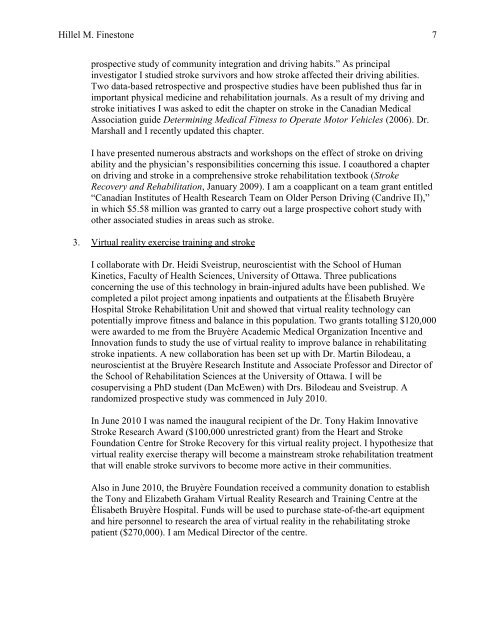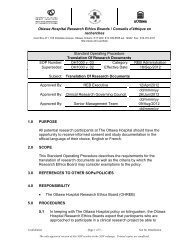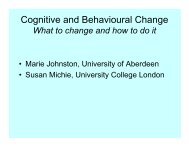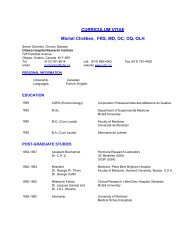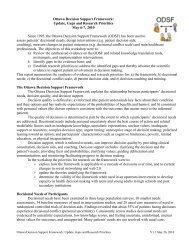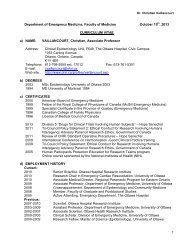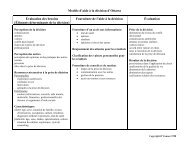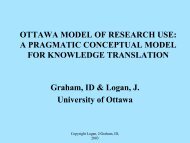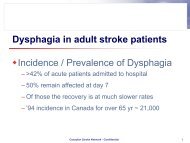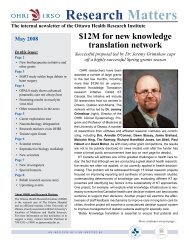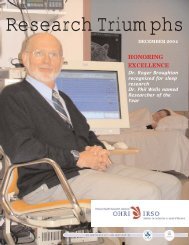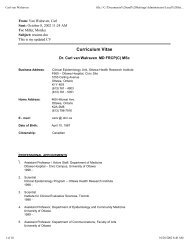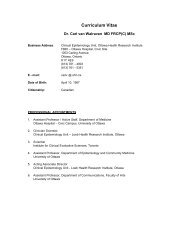CURRICULUM VITAE - The Ottawa Hospital Research Institute
CURRICULUM VITAE - The Ottawa Hospital Research Institute
CURRICULUM VITAE - The Ottawa Hospital Research Institute
Create successful ePaper yourself
Turn your PDF publications into a flip-book with our unique Google optimized e-Paper software.
Hillel M. Finestone 7<br />
prospective study of community integration and driving habits.” As principal<br />
investigator I studied stroke survivors and how stroke affected their driving abilities.<br />
Two data-based retrospective and prospective studies have been published thus far in<br />
important physical medicine and rehabilitation journals. As a result of my driving and<br />
stroke initiatives I was asked to edit the chapter on stroke in the Canadian Medical<br />
Association guide Determining Medical Fitness to Operate Motor Vehicles (2006). Dr.<br />
Marshall and I recently updated this chapter.<br />
I have presented numerous abstracts and workshops on the effect of stroke on driving<br />
ability and the physician’s responsibilities concerning this issue. I coauthored a chapter<br />
on driving and stroke in a comprehensive stroke rehabilitation textbook (Stroke<br />
Recovery and Rehabilitation, January 2009). I am a coapplicant on a team grant entitled<br />
“Canadian <strong>Institute</strong>s of Health <strong>Research</strong> Team on Older Person Driving (Candrive II),”<br />
in which $5.58 million was granted to carry out a large prospective cohort study with<br />
other associated studies in areas such as stroke.<br />
3. Virtual reality exercise training and stroke<br />
I collaborate with Dr. Heidi Sveistrup, neuroscientist with the School of Human<br />
Kinetics, Faculty of Health Sciences, University of <strong>Ottawa</strong>. Three publications<br />
concerning the use of this technology in brain-injured adults have been published. We<br />
completed a pilot project among inpatients and outpatients at the Élisabeth Bruyère<br />
<strong>Hospital</strong> Stroke Rehabilitation Unit and showed that virtual reality technology can<br />
potentially improve fitness and balance in this population. Two grants totalling $120,000<br />
were awarded to me from the Bruyère Academic Medical Organization Incentive and<br />
Innovation funds to study the use of virtual reality to improve balance in rehabilitating<br />
stroke inpatients. A new collaboration has been set up with Dr. Martin Bilodeau, a<br />
neuroscientist at the Bruyère <strong>Research</strong> <strong>Institute</strong> and Associate Professor and Director of<br />
the School of Rehabilitation Sciences at the University of <strong>Ottawa</strong>. I will be<br />
cosupervising a PhD student (Dan McEwen) with Drs. Bilodeau and Sveistrup. A<br />
randomized prospective study was commenced in July 2010.<br />
In June 2010 I was named the inaugural recipient of the Dr. Tony Hakim Innovative<br />
Stroke <strong>Research</strong> Award ($100,000 unrestricted grant) from the Heart and Stroke<br />
Foundation Centre for Stroke Recovery for this virtual reality project. I hypothesize that<br />
virtual reality exercise therapy will become a mainstream stroke rehabilitation treatment<br />
that will enable stroke survivors to become more active in their communities.<br />
Also in June 2010, the Bruyère Foundation received a community donation to establish<br />
the Tony and Elizabeth Graham Virtual Reality <strong>Research</strong> and Training Centre at the<br />
Élisabeth Bruyère <strong>Hospital</strong>. Funds will be used to purchase state-of-the-art equipment<br />
and hire personnel to research the area of virtual reality in the rehabilitating stroke<br />
patient ($270,000). I am Medical Director of the centre.


